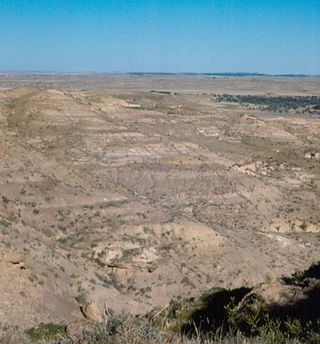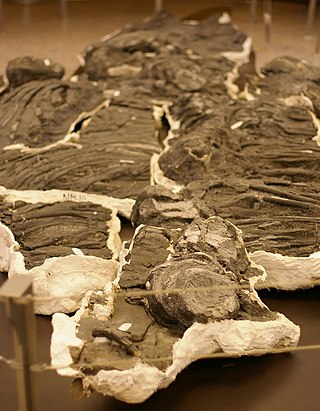
Lessemsaurus is an extinct genus of sauropodiform dinosaur belonging to Lessemsauridae.

The Lance (Creek) Formation is a division of Late Cretaceous rocks in the western United States. Named after Lance Creek, Wyoming, the microvertebrate fossils and dinosaurs represent important components of the latest Mesozoic vertebrate faunas. The Lance Formation is Late Maastrichtian in age, and shares much fauna with the Hell Creek Formation of Montana and North Dakota, the Frenchman Formation of southwest Saskatchewan, and the lower part of the Scollard Formation of Alberta.

The Kimmeridge Clay is a sedimentary deposit of fossiliferous marine clay which is of Late Jurassic to lowermost Cretaceous age and occurs in southern and eastern England and in the North Sea. This rock formation is the major source rock for North Sea oil. The fossil fauna of the Kimmeridge Clay includes turtles, crocodiles, sauropods, plesiosaurs, pliosaurs and ichthyosaurs, as well as a number of invertebrate species.

Shastasauridae is an extinct family of Triassic ichthyosaurs. The family contains the largest known species of ichthyosaurs, which include some of and possibly the largest known marine reptiles.

The Caturrita Formation is a rock formation found in Rio Grande do Sul, Brazil. Its sediments were deposited in the Paraná Basin. The formation is from the Upper Triassic and forms part of the Santa Maria Supersequence in the upper section of the Rosário do Sul Group.

Anchisauria is an extinct clade of sauropodomorph dinosaurs that lived from the Late Triassic to the Late Cretaceous. The name Anchisauria was first used Haekel and defined by Galton and Upchurch in the second edition of The Dinosauria. It is a node-based taxon containing the most recent common ancestor of Anchisaurus polyzelus and Melanorosaurus readi, and all its descendants. Galton and Upchurch assigned a family of dinosaurs to the Anchisauria: the Melanorosauridae. The more common prosauropods Plateosaurus and Massospondylus were placed in the sister clade Plateosauria.

Lilstock is a hamlet in the civil parish of Stringston in Somerset, England. It is 12 miles (19 km) north-west of Bridgwater, and 8 miles (13 km) north-east of Williton. It is on the coast of Bridgwater Bay on the Bristol Channel, near the Hinkley Point nuclear power stations.
The Quebrada del Barro Formation is a geological formation of the Marayes-El Carrizal Basin in San Juan Province, Argentina. This formation is the most fossiliferous portion of the Triassic Marayes Group, and is also the youngest unit of the group, overlying the El Carrizal Formation. An unconformity at the top of the Quebrada del Barro Formation separates it from the Cretaceous-age Los Riscos Formation of the El Gigante Group. Part of the formation may be made into a provincial park following the discovery of the fossils of Ingentia, a giant sauropodomorph dinosaur which helped elucidate the early evolution of sauropods.

The Blue Lias is a geological formation in southern, eastern and western England and parts of South Wales, part of the Lias Group. The Blue Lias consists of a sequence of limestone and shale layers, laid down in latest Triassic and early Jurassic times, between 195 and 200 million years ago. The Blue Lias is famous for its fossils, especially ammonites.
The Cambridge Greensand is a geological unit in England whose strata are earliest Cenomanian in age. It lies above the erosive contact between the Gault Formation and the Chalk Group in the vicinity of Cambridgeshire, and technically forms the lowest member bed of the West Melbury Marly Chalk Formation. It is a remanié deposit, containing reworked fossils of late Albian age, including those of dinosaurs and pterosaurs.

The Almond Formation is a geological formation of Late Cretaceous age in Wyoming. It was deposited in marsh, deltaic, lagoonal, estuarine, and shallow marine environments along the western shore of the Western Interior Seaway. It consists primarily of fine- to medium-grained sandstone, siltstone, shale, and coal. Fossils from the Almond Formation include remains of dinosaurs and plants.

The Prince Creek Formation is a geological formation in Alaska with strata dating to the Early Maastrichtian stage of the Late Cretaceous. Dinosaur remains are among the fossils that have been recovered from the formation.
The Popo Agie Formation is a Triassic geologic formation that crops out in western Wyoming, western Colorado, and Utah. It was deposited during the Late Triassic in fluvial (river) and lacustrine (lake) environments that existed across much of what is now the American southwest. Fragmentary fossils of prehistoric reptiles and amphibians, including pseudosuchian reptiles and temnospondyl amphibians, have been discovered in the Popo Agie Formation. Dinosaur remains are also among the fossils that have been recovered from the formation, although none have yet been referred to a specific genus.

The Speeton Clay Formation (SpC) is a Lower Cretaceous geological formation in Yorkshire, northern England. Unlike the contemporaneous terrestrial Wealden Group to the south, the Speeton Clay was deposited in marine conditions. The most common fossils in the unit are belemnites, followed by ammonites and the lobster Meyeria ornata. Dinosaur remains are among the fossils that have been recovered from the formation, although none have yet been referred to a specific genus.

The Saltwick Formation is a Middle Jurassic geologic formation in Yorkshire and the western North Sea. It is primarily Aalenian in age. Fossil footprints, assigned to the tetrapod ichnogenus Characichnos, as well as stegosaur tracks have been reported from the formation. An indeterminate sauropod, nicknamed Alan, has also been reported from the formation.
The Katrol Formation is a Mesozoic geologic formation in India. Fossil sauropod tracks have been reported from the formation. An indeterminate ophthalmosaurid ichthyosaur is also known from the formation in the Kutch district.
The Irhazer Shale or Irhazer II Formation is a Middle Jurassic geologic formation of the Irhazer Group in the Agadez Region of Niger. Fossil ornithopod tracks have been reported from the formation. The dinosaur Spinophorosaurus is known from the formation.

This timeline of ichthyosaur research is a chronological listing of events in the history of paleontology focused on the ichthyosauromorphs, a group of secondarily aquatic marine reptiles whose later members superficially resembled dolphins, sharks, or swordfish. Scientists have documented ichthyosaur fossils at least as far back as the late 17th century. At that time, a scholar named Edward Lhuyd published a book on British fossils that misattributed some ichthyosaur vertebrae to actual fishes; their true nature was not recognized until the 19th century. In 1811, a boy named Joseph Anning discovered the first ichthyosaur fossils that would come to be scientifically recognized as such. His sister Mary would later find the rest of its skeleton and would go on to become a respected fossil collector and paleontologist in her own right.

Ichthyotitan is an extinct genus of giant ichthyosaur from the Late Triassic (Rhaetian), known from the Westbury Mudstone Formation in Somerset, England. It is believed to be a shastasaurid, extending the family's range by 13 million years up to the latest Triassic. The discovery of Ichthyotitan has been considered evidence that shastasaurids were still thriving until their disappearance in the Triassic–Jurassic extinction event.














